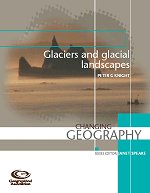| Glaciers and Glacial Landscapes
Peter G. Knight |

"Essential purchase"
|
Author's Introduction
Research on glaciers is carried out by a wide range of scientists including physicists, chemists, climatologists, oceanographers and mathematicians. Their work involves field observation, laboratory experiments, satellite remote sensing and numerical modelling. This book looks particularly at the work of glaciologists (who study ice and snow) and geomorphologists (who study landforms). Their research has progressed so rapidly that school curricula and textbooks struggle to keep up with new developments in the subject. Recent discoveries have led to major reassessments of fundamental questions such as how glaciers move, how they erode rock and deposit sediment, and how they respond to global warming. These new discoveries challenge traditional views of glaciers and glaciated environments. Because of their impact on hydrological and climatic systems, glaciers have a global impact. Tropical ocean currents are affected by glaciers in the Arctic, and Britain’s coastline could be devastated by ice melting in Antarctica. Glaciers hold more than 75% of the world’s fresh water, and provide irrigation for some of the planet’s most densely populated areas. Ten per cent of the Earth’s land surface is covered by glaciers. Twice this area has been exposed by retreating glaciers in the last 20,000 years. These glaciated landscapes include most of Great Britain as well as much of northern Europe and North America. This book will help you to learn about the importance of glaciers, and to explore some of the new questions that science is asking about glaciers. To help you in your learning, Information Boxes and Case Studies have been used to provide extra detail about specific issues, and Activity Boxes offer practical activities to help you focus your thinking and develop your understanding of important ideas. Teacher informationThe Changing Geography series seeks to help you to alert your 16–19 students to the fact that many of the ideas currently being taught and researched in universities are also relevant to them. By introducing your students to concepts and ideas that tend to be excluded from conventional 16–19 school texts, Changing Geography helps to close the gap between school and university geography and helps prepare your students for the types of approaches they will need to use during their university studies. Each book is illustrated with contemporary case studies and includes numerous suggestions for discussion, projects and fieldwork. Glaciers and glacial landscapes explores the relationships between the changing global environment, the characteristics of glaciers, and the impact of glaciation on both landscapes and human activity. Identifying the important processes in glaciology and glacial geomorphology, it encourages students to recognise the linkages both between global systems and local conditions and between past environments and present-day landscapes. The study of glaciers is increasingly important in the context of environmental change, and recent developments in the subject have seriously challenged traditional approaches. Glaciers and glacial landscapes not only reviews our basic understanding of glaciers within the global system, but also identifies ways in which that understanding is changing in response to new scientific research. Student informationThe Changing Geography series introduces you to the concepts and ideas that are currently being taught and researched in higher education. The study of glaciers has become increasingly important in the context of global climate change, and our understanding of how glaciers work as part of a complex global system has grown rapidly in recent years. Because glaciers and ice sheets are part of a constantly changing global environment, they can be used both to work out what the world has been like in the past and to predict what it will be like in the future. Global warming, sea-level change, glacier fluctuations, glacier hazards, and spectacular changes to the landscape are all part of the same geographical system. With a combination of information, case studies, and activities that you can carry out yourself, this book will help you to understand that system. |
||
| Other books by Peter Knight include
How to do your essays, exams and coursework in Geography... How to do your dissertation in Geography... Glaciers. |
|||
